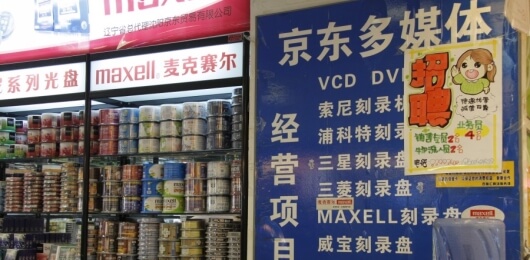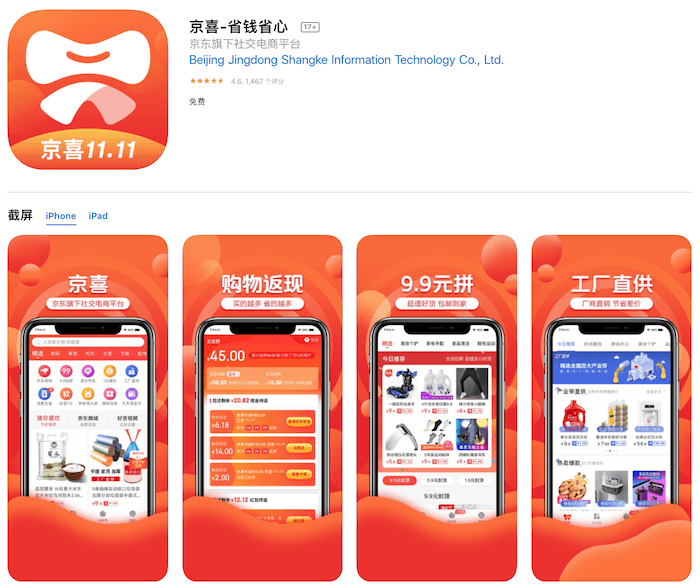China Internet Stats, Trends, Insights
CIW » China E-commerce »
JD.com or JD, well known as Jingdong in China, is one of the top e-commerce online shopping platforms in China, owned by Chinese company JD.com Inc.
Jingdong’s main competitors include Taobao, Tmall, and Pinduoduo.
About Jingdong
 Chinese e-commerce platform Jingdong (a.k.a. JD.com), formerly known as 360Buy, is among the top 3 e-commerce shopping platforms in China.
Chinese e-commerce platform Jingdong (a.k.a. JD.com), formerly known as 360Buy, is among the top 3 e-commerce shopping platforms in China.
JD.com offers a vast selection of products, across every major category (electronics, apparel and home furnishings, FMCG, fresh food, home appliances and others), and delivering them at fast speeds to Chinese consumers.
Download (annual subscribers) Research: JD.com’s Autonomous Warehouse
Jingdong Business Overview
Get an overview of JD.com by watching the video below:
JD E-commerce Verticals
In addition to its online shopping website JD.com with mobile apps for Android and iOS, JD manages several e-commerce verticals:
Jingxi, a platform JD launched in Sep 2019 to take on Pinduoduo for lower-tier cities in China (more in the history section)
JD.com cross-border e-commerce operation through JD Worldwide (import retail; launched in 2015), a direct competitor to Tmall Global and Kaola.
And for international markets, JD Global sells to overseas Chinese.
Find out the global e-commerce properties owned by JD.com Inc. here.
JD.com started with a focus on online direct sales selling electronics products on 360buy.com. As it gained popularity, it started accepting other retailers as an e-commerce marketplace.
One of the two major online shopping festivals in China “618” was started by Jingdong.
Jingdong’s annual active customer accounts increased by 24.8% to 387.4 million in the twelve months ended March 31, 2020 from 310.5 million in the twelve months ended March 31, 2019.
Mobile daily active users in March 2020 increased by 46% as compared to March 2019.
Compare Statistics: total annual customers – Alibaba vs JD vs Pinduoduo
JD.com has one of the largest fulfillment infrastructure of any e-commerce company in the world.
As of March 31, 2021, JD.com operated 32 “Asia No. 1” logistics parks, which are among the largest and most automated smart fulfillment centers in Asia. JD.com also leverages a network of over 1,000 warehouses with a total of over 21 million square meters, including warehouse space of cloud warehouses managed under the JD Logistics Open Warehouse Platform.
To find out more about the company beyond e-commerce, visit JD.com Inc.
Jingdong History

Jingdong was founded by Liu Qiangdong (a.k.a. Richard Liu) in July 1998, and its B2C platform went online in 2004.

On June 18, 1998, Richard Liu committed RMB12,000 of his savings to lease a four-square-meter retail unit in Beijing’s technology hub of Zhongguancun. Here he established JD Multimedia, the business that would eventually become JD.com.
When the SARS outbreak affected China in 2003, JD founder Richard Liu saw an opportunity to utilize the potential of the Internet to support his business. In 2004, JD was moved online. June 18, 2004 is now considered JD’s first 618 promotion.
It started as an online magneto-optical store, but soon diversified, selling electronics, mobile phones, computers, etc. Jingdong Mall changed the domain name to 360buy.com in June 2007, and to JD.com in 2013.
Jingdong’s gross merchandise volume, or GMV, increased from RMB32.7 billion in 2011 to RMB73.3 billion in 2012 and RMB125.5 billion (US$20.7 billion) in 2013.
The number of products JD.com offer through Jingdong’s online direct sales and marketplace JD.com has grown from approximately 1.5 million stock keeping units, or SKUs, as of December 31, 2011 to approximately 7.2 million SKUs as of December 31, 2012 to approximately 25.7 million SKUs as of December 31, 2013 and further to approximately 40.2 million as of March 31, 2014.
Electronics products and home appliances accounted for 80.1%, 65.3% and 63.6% of Jingdong’s total GMV in 2011, 2012 and 2013, respectively, and general merchandise and others for 19.9%, 34.7%, and 36.4%.
JD.com had 12.5 million, 29.3 million and 47.4 million active customer accounts and fulfilled approximately 65.9 million, 193.8 million and 323.3 million orders in 2011, 2012 and 2013, respectively.
JD.com made a strategic decision in 2007 to build and operate Jingdong’s own nationwide fulfillment infrastructure. JD.com operated 86 warehouses with an aggregate gross floor area of approximately 1.5 million square meters in 36 cities and 1,620 delivery stations and 214 pickup stations in 495 cities across China as of March 31, 2014, and had 24,412 delivery personnel, 11,145 warehouse staff and 5,832 customer service personnel as of April 1, 2014.
Leveraging this nationwide fulfillment infrastructure, JD.com deliver a majority of the orders directly to customers Jingdong’s shelves, over 70% of which JD.comre delivered on the day the order was placed or the day after.
As of March 31, 2014, JD.com provided same-day delivery in 43 cities under Jingdong’s 211 program and next-day delivery in another 256 cities across China.
2014: WeChat Partnership & IPO
In March, JD formed a strategic partnership with Tencent, giving JD exclusive access to Tencent’s WeChat and Mobile QQ platforms.
On May 22, JD became China’s first major e-commerce company to list on New York’s NASDAQ stock exchange, under the ticker ‘JD.’
In July, JD Finance launched China’s largest crowdfunding platform.
In October, Jingdong’s automated and most advanced logistics center, the Asia No. 1 Warehouse in Shanghai, began operations.
2016: Walmart Partnership
In June, JD.com and Walmart announced a strategic alliance.
As part of the agreement JD took control of Yihaodian’s marketplace, Walmart acquired a 5% stake in JD.com and they agreed to a number of different areas of cooperation covering the online and O2O areas of the two companies’ businesses in China.
September 2019: Jingxi

In September, JD.com officially launched its social e-commerce platform Jingxi as part of its strategy to penetrate into lower-tier cities and compete with Pinduoduo.
Social e-commerce in China has much higher conversion rates than traditional ones. Social e-commerce GMV reached 626.85 billion yuan in 2018 with an increase of 255.8%.
It’s expected to continue the fast growth and exceed 1.3 trillion yuan in 2019 and 2.86 trillion in 2021. 80% of internet shoppers are using social e-commerce channels.
Jingxi is available to consumers across multiple channels including the standalone Jingxi app, Jingxi mini program, and a WeChat first-level entry point. Combining social media and retail, Jingxi provides products at attractive prices.
Jingxi also has partnered with domestic manufacturers in over one hundred industrial clusters, serving as a bridge between manufacturers and consumers. During the Singles Day promotion season, approximately 75% of Jingxi’s new users came from lower-tier cities, and approximately 55% of total Jingxi users were female.
JD FAQ
Who owns Jingdong?
As of February 28, 2019, Liu Qiangdong, CEO of Jingdong, was the second largest shareholder with a 15.4% stake in the company. Tencent holds 17.8% of the shares, making it the largest shareholder. In addition, Wal-Mart holds a 9.9% stake in Jingdong and is its third largest shareholder.
What does Jingdong mean?
Based on information shared on China internet, the name “Jingdong” comes from two persons’ name: CEO Liu Qiangdong (dong) and his ex-girlfriend Gong Xiaojing (jing).
What digital properties does JD operate?
JD runs domestic e-commerce website JD.com and cross-border e-commerce through JD Worldwide (import). And, it uses JD Global sells to overseas Chinese; JoyBuy.com runs JD’s export e-commerce retail operation.
How is Jingdong different from Tmall?
Jingdong focuses on selling directly to consumers on its platform while Tmall mainly operates as a marketplace for companies to sell to consumers.
What is Jingdong Worldwide?
Jingdong Worldwide is Jingdong’s import cross-border e-commerce platform, selling overseas products directly to consumers in China. Its competitors include Kaola and Tmall Global.


